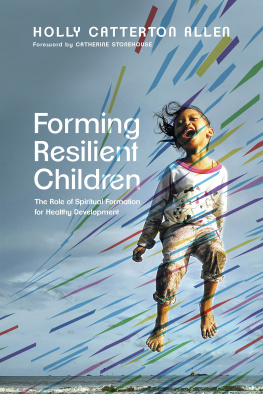ORDINARY
MAGIC
Resilience
in Development

ANN S. MASTEN

THE GUILFORD PRESS
New York London
To the memory of Ruth,
a natural protective factor in the lives of children
Epub Edition ISBN: 9781462517268; Kindle Edition ISBN: 9781462517275
2014 The Guilford Press
A Division of Guilford Publications, Inc.
72 Spring Street, New York, NY 10012
www.guilford.com
All rights reserved
No part of this book may be reproduced, translated, stored in a retrieval system, or transmitted, in any form or by any means, electronic, mechanical, photocopying, microfilming, recording, or otherwise, without written permission from the publisher.
Last digit is print number: 9 8 7 6 5 4 3 2 1
Library of Congress Cataloging-in-Publication Data
Masten, Ann S.
Ordinary magic : resilience in development / Ann S. Masten.
pages cm
Includes bibliographical references and index.
ISBN 978-1-4625-1716-9 (hardback)
1. Resilience (Personality trait) in children. 2. Child psychology.
3. Child welfare. I. Title.
BF723.R46M37 2014
155.4 1824dc22
2014017571
Ann S. Masten, PhD, is a Regents Professor and the Irving B. Harris Professor of Child Development in the Institute of Child Development at the University of Minnesota. She is past president of the Society for Research in Child Development, a Fellow and former Division President (Division 7: Developmental Psychology) of the American Psychological Association (APA), and a Fellow of the Association for Psychological Science. She serves as a member of the Board on Children, Youth, and Families for the Institute of Medicine and the National Academies. Dr. Masten is an internationally known expert on resilience in human development, with over 150 publications in scientific journals and books. She is a recipient of the 2014 Urie Bronfenbrenner Award for Lifetime Contribution to Developmental Psychology in the Service of Science and Society from the APA.
N early four decades ago, I was drawn into the newly emerging science of resilience as I embarked on doctoral studies in clinical psychology at the University of Minnesota. A group of pioneering investigators who studied children who were, for various reasons, at risk had noticed the striking variation among individuals exposed to adversity, with some young people thriving or at least holding their own despite their high-risk background or hazardous experiences. We were curious about the roots of this observable resilience: How do some individuals fare so well while others struggle? Would it be possible to foster resilience in other young people at risk if we understood more about this phenomenon?
Three waves of research followed as scientists and their students tried to understand resilience in human development, initially describing the variation in adaptation observed in risky or stressful circumstances and later advancing to studies of processes that might account for the variation, particularly the pathways to positive outcomes. Ultimately the goal was to inform efforts to promote resilience. A new century and new technologiesincluding brain imaging, genetic assessment, and statistics for modeling complex systemsushered in the fourth wave of resilience science, marked by efforts to integrate knowledge across system levels to predict or promote positive adaptation in the context of adversity.
In 2001, I published an essay called Ordinary Magic: Resilience Processes in Development, which briefly summarized conclusions I had reached after 25 years of work in the field, beginning as a student. This essay would become my most cited paper, and I soon realized that I wanted to elaborate on those conclusions. I began to plan this book, but ongoing research, teaching, and administrative responsibilities slowed the process of producing it. With time, I felt a growing urgency to integrate the ideas and findings on resilience in children and youth. I had witnessed three major waves of resilience science and knew that a major new wave was coming. I also knew that the science would keep evolving and improving but with the fourth wave rising, the time was ripe for a book-length summation of progress to date.
Internationally, resilience science is burgeoning in many different fields as scientists study the variation in the responses of complex systems to challenges. Global catastrophes in the form of terror attacks, natural disasters, climate change, pandemics, economic crisis, and warfare are motivating action at many levels of policy and intervention in an effort to protect life, promote global well-being, and improve the odds of resilience in populations threatened by adversities. There is growing recognition that resilience in children is interconnected with the resilience of families, communities, governments, economies, and ecologies.
APPROACH AND ORGANIZATION
My goal in this volume is to describe the progress in research on resilience in children and youth to date from the vantage point of an early participantobserver. In this volume, I discuss the origins and progress of developmental resilience science, the research models and strategies that evolved, exemplary findings from illustrative lines of work, and the implications of what we know so far for practice and future science. Fundamental concepts are carefully defined and illustrated with both case material and empirical examples. Three major domains of research are highlighted, including longitudinal studies of child adaptation in relation to stress and adversity, research on socioeconomically disadvantaged children, and studies of mass trauma related to war and disaster.
Diverse studies from many different places and kinds of adversities point to a fundamental set of adaptive systems that account for much of the capacity for doing well or recovering well in the context of adversity exposure. This set, which I have called the short list, provides important clues to key protective factors in the lives of young people with implications for preventive interventions.
The focus of the book is on individual resilience observed at a behavioral level, but even in the initial waves of research, studies that included other system levels have played an important part in accounting for resilience. Chapters of the book highlight the rapidly emerging science on the neurobiology of resilience and research on three contexts of child development that are central to the lives and resilience of children: families, schools, and culture. Wherever possible, I have tried to provide international perspectives and research examples. Though relatively neglected in early waves, global research is expanding rapidly with ever greater attention to cultural context and resilience in the economically developing parts of the world.
Resilience science has transformed multiple fields of practice, shifting models and intervention strategies toward strength-focused models and goals. A resilience framework for action is delineated in one of the closing chapters. The book concludes with a discussion of enduring controversies and where I see the study of resilience headed.
Long a believer that complex ideas can be described in straightforward language, I have attempted to write in a style accessible to diverse readers while simultaneously doing justice to the ideas and provocative findings. Compelling case examples are included, some of which are drawn from non-Western cultures and countries, such as Sierra Leone and Cambodia. These individual life examples serve the dual purpose of illustrating important points in the resilience literature and bringing the phenomenon of resilience to life. A glossary of terms is provided in .
Next page





